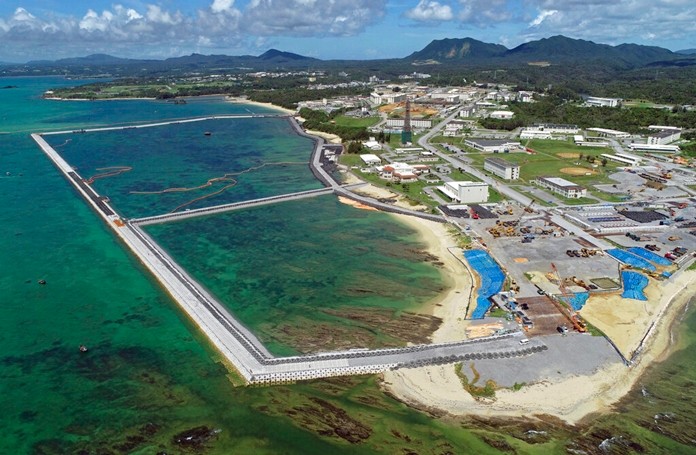
TOKYO (AP) — The relocation of a U.S. Marine Corps base to a less-crowded area of the southern Japanese island of Okinawa will take more than twice as much money and time as previously estimated because of the need to stabilize the reclaimed land it will be built on, Japan’s government said Wednesday.
The Defense Ministry said the relocation of U.S. Marine Corps Air Station Futenma from densely populated Ginowan to Henoko on Okinawa’s eastern coast will cost 930 billion yen ($8.5 billion) and take 12 years, pushing its completion into the 2030s. That adds more than a decade to the plan, which has already been delayed by more than 20 years because of local opposition and other reasons.
Under an earlier plan agreed to by Tokyo and Washington in 2013, construction was to cost about 350 billion yen ($3.2 billion) and take five years, with completion expected in about 2022.
Most of the additional cost and time is required to stabilize and strengthen reclaimed land off the coast of Henoko that will be used for runways, the ministry said. It presented its new estimate to a panel of Japanese experts discussing the relocation plans.
Experts have found parts of the sea bottom at the planned reclamation site to be “as soft as mayonnaise” and needing to be reinforced.
Many Okinawans, including Gov. Denny Tamaki, oppose the relocation, saying the base should be entirely removed from the island. The heavy U.S. military presence on Okinawa has been a source of a long-running conflict between the island and Washington and Tokyo.
Japan’s central government forcibly began reclamation work in December 2018 despite repeated protests by Okinawa.
Tamaki is expected to also reject a central government application for a local government permit to carry out additional land reinforcement, which is likely to reignite tension and further delay the relocation.
Okinawa’s vice governor, KichiroJahana, told reporters that “The construction should be stopped immediately. It’s a good opportunity to rethink the plan, taking into consideration a nationwide debate.”
About half of the 50,000 American troops in Japan are stationed in Okinawa. The 30 U.S. installations on the island account for more than 70% of the area used by the U.S. military in Japan, leading Okinawa to protest that it is shouldering more than its share of the burden.
Opponents also say the relocation plan should be scrapped for environmental reasons because the site is a habitat for dugongs and corals.
U.S. President Donald Trump and Japanese Prime Minister Shinzo Abe reaffirmed their commitment to pursue the Henoko plan in 2017, calling it the only solution that avoids continued use of Futenma. The plan was developed after the 1995 rape of a schoolgirl, in which three U.S. servicemen were convicted, reigniting simmering Okinawan opposition to the U.S. bases.
Tokyo and Washington have since agreed on the return of the current 1,100-acre (445-hectare) Futenma base to Japanese control after operations are moved to Henoko. The plan requires 1,800-meter (5,900-foot) runways in a V configuration on reclaimed land in Henoko Bay near the U.S. military’s Camp Schwab.
 |
 |
 |





